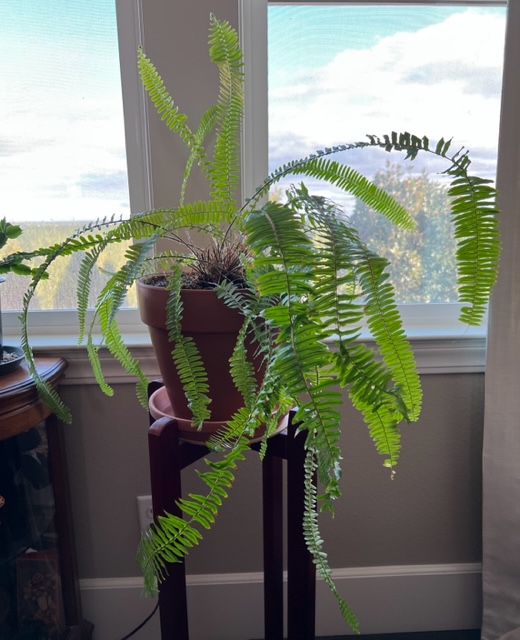I recently re-potted my Kimberly Queen Fern because she was dropping fronds and looking very poorly. I thought I was following the best care instructions for this plant, but my fern was suffering! The root ball was dry. WHAT?? So, I removed all the dead fronds and planted my baby in a larger new terra-cotta pot, but it was time to verify the needs of my fern again.
The Kimberly Queen Fern is native to Australia and New Zealand but has become popular in the United States as a houseplant. It is known for its long, graceful fronds and its easy-care characteristics. The plant is hardy and supposedly tolerant of low humidity, heat, and poor watering. It prefers bright indirect light or dappled shade. The Kimberly Queen Fern was first introduced in the United States in the late 1800s. Over time, it has become increasingly popular due to its ease of care and attractive foliage. In addition to being an ideal indoor plant, the Kimberly Queen Fern can also be grown outdoors as a ground cover or in containers or hanging baskets.
The Kimberly Queen Fern (Nephrolepis obliterata) is an excellent addition to any home, office, or garden. Its lush and vibrant foliage brings life to any space. But like all houseplants, the Kimberly Queen Fern requires care and attention to thrive. Here are the five critical points of care and the re-potting guidelines for this fern:
1. Location: Kimberly Queen Ferns prefer indirect sunlight or semi-shade; they should not be exposed to direct sunlight as it can scorch the leaves. An east or north-facing window is the best location for this type of fern.
2. Watering: the Kimberly Queen Ferns need moist but not soggy soil to survive. Therefore, aim to water the fern every two to three days, ensuring that the top inch of soil is always moist.
3. Humidity: the Kimberly Queen Ferns appreciate a humid atmosphere around them. Misting the fronds with a spray bottle regularly can help create an environment more suitable for this type of fern.
4. Fertilizer: Kimberly Queen Ferns do not require any fertilizer; however, using a balanced liquid houseplant fertilizer every month can help keep your plant looking its best.
5. Re-potting: Kimberly Queen Ferns will need re-potting approximately once every two years when they outgrow their pot and soil. Replacing the potting mix with fresh soil and ensuring the root ball is tight enough to pack will help keep your Kimberly Queen Fern healthy.
Reviewing these five critical points of care and re-potting guidelines, I should have no problem keeping my Kimberly Queen Fern healthy and happy! I’ll keep you updated.
*Please note that this blog post is for educational purposes only and is not intended to be used as a definitive guide or advice. Please consult an expert before making any decisions regarding the care of your plants. I am not a plant expert.*
Thank you for reading this blog post, and if you have any questions or comments, please leave them in the Comments section below.
Copyright © 2019 I Don’t Know All The Answers, Nikki Mastro.
All of my photographs and documents are Copyrighted.
No part of this website, including text, photographs, and documents, may be reproduced, stored in a retrieval system, or transmitted in any form or by any means without written permission from the copyright holder. All unauthorized use is strictly prohibited. If you choose to copy or share any information from my site, you must provide a link to the source. I appreciate your cooperation.


Have recent climate changes in California led to an increase in tornado formation in the state, and if so, what are the potential implications for residents and infrastructure?
What a great question! I have recently written about tornadoes occurring in California but not as a result of climate change. May I use your question for a topic for a future article? I will cite the question from you with your permission. Let me know. Thank you again!